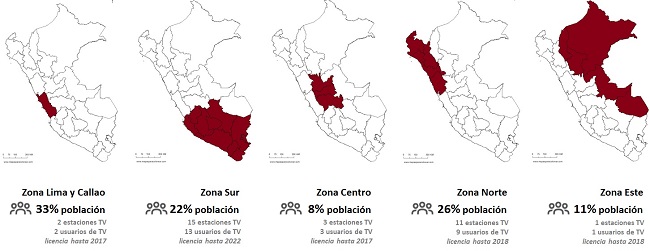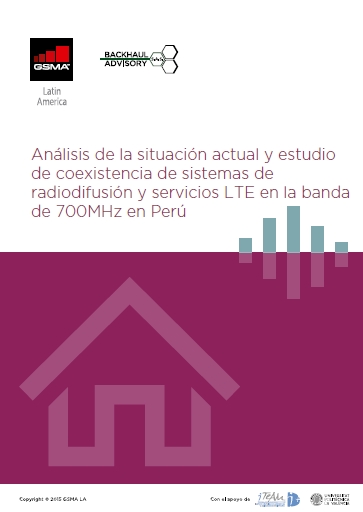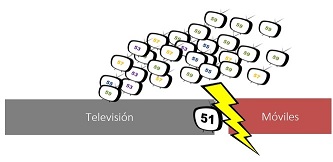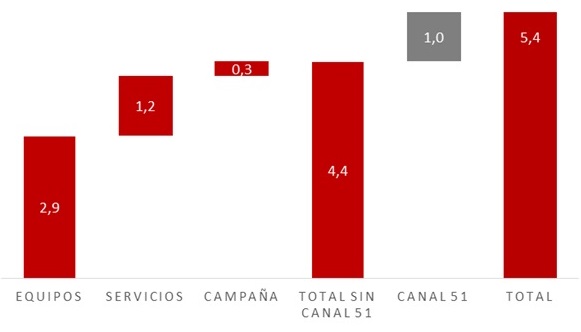Backhaul Advisory for the GSMA – 2015
The Digital dividend is key to improving coverage, universalizing Internet access and bridging the digital divide.
The Digital Dividend (or 700 MHz band) is the spectrum portion located between 698-806 MHz. Currently used in Peru for broadcasting services, it has been identified by the ITU for the provision of mobile services. This band will allow to provide better broadband coverage in suburban and rural areas thus contributing to the reduction of the digital divide. It will also allow to improve the quality of service in homes and buildings. In addition, allocating it to mobile operators contributes to the growth of the country’s economy, boosts investments in the sector, promotes employment and encourages innovation.
The Peruvian Ministry of Transport and Communications (MTC) decided to allocate this band to mobile services, in line with other countries in Latin America. The band was divided into 3 blocks of 15 + 15 MHz and is expected to be auctioned in 2016.
Analysis of 700 Mhz TV-Station Occupation by Area

However, none of the three 700 MHz band spectrum blocks is available for use in mobile broadband services anywhere in the country because they are currently being used by analogue TV signals. Given the high-band occupation, the most critical areas are the southern and northern regions of the country (representing 48% of the national population). There are 32 TV broadcast stations operating on channels 53, 55, 57 and 59.
This is the situation that motivated the study entrusted to the Backhaul Advisory Consulting Firm and the University of Valencia to analyze technical conditions to ensure that LTE mobile broadband services can coexist with analogue and digital TV broadcasting services. The study recommended cleaning and allocating the 700 MHz band in 2016.

Download: Análisis de la situación actual y estudio
de coexistencia de sistemas de radiodifusión y servicios LTE en la banda de 700MHz en Perú
The 700 MHz band is currently not available for mobile services in Peru.
For mobile services to use this Band, 32 national analogue TV broadcast signals need to be relocated (specifically channels 53, 55, 57 and 59). In addition, 10 other TV signals can be found in channel 51 (adjacent channel), very close to the spectrum for mobile services.

Actual scenarios must be considered for the efficient migration and correct use of this band by mobile services. On the one hand, the coexistence in adjacent bands (between the TV signals that will be relocated below the 698 MHz and the mobile services that are above) and coexistence within the 700 MHz band (TV signals which will continue to operate above 698 MHz).
 In the first case, the risk of interference with the adjacent band generated in the LTE uplink (communication between the device and the base station) must be considered. In Channel 51 (last channel prior to spectrum allocated to mobile telephony), there are 10 other broadcasters that could generate interference with the first block of the band. These signals should also be relocated so that the Digital Dividend can be used in its entirety for mobile services, avoiding interference and optimizing its use.
In the first case, the risk of interference with the adjacent band generated in the LTE uplink (communication between the device and the base station) must be considered. In Channel 51 (last channel prior to spectrum allocated to mobile telephony), there are 10 other broadcasters that could generate interference with the first block of the band. These signals should also be relocated so that the Digital Dividend can be used in its entirety for mobile services, avoiding interference and optimizing its use.
On the other hand, more than 350 TV service authorizations are located in the space where the signals currently located in the 700 MHz band (channels 14 to 51) should be moved. Therefore, in accordance with the Digital Terrestrial Television Implementation Master Migration Plan, no frequencies would be available in some regions for the relocation of TV signals migrated from the 700 MHz band.
Recommendations for cleaning and assigning the 700 MHz band in 2016: the role of the State, adjustments to migration plan and release of Channel 51.
The Peruvian State, through the MTC, should be the one responsible for coordinating these activities and guaranteeing the migration of signals, and not broadcasters or mobile operators. An efficient migration is as important as the decision to allocate this spectrum to mobile services, and the corresponding planning, implementation and control must be the responsibility of the State to mediate among the parties should any issue or delay take place.
The Master Migration Plan should be adjusted to include the migration of Channel 51 signals and adjust the allocation of frequencies in the lower part of the UHF band, thus including all the migrated analogue transmissions.
Costs related to the migration and TV-LTE interference mitigation should be deducted from the monies raised from the 700 MHz band auction, so no additional burden is imposed on the State. The cost estimated by the Consulting Firm responsible for this study ranges from USD 4.4 to 5.4 million.
TV Signal Migration Cost Analysis

Early and detailed planning of the migration project involves the creation and formalization of a Trust and Coordination Committee to define and approve the technical, legal and contractual conditions and must be accompanied by a parallel educational campaign to help users understand their role in the migration process.
The decision of the Peruvian State, made through the MTC, to assign the Digital Dividend to mobile services will have a significant impact on society. However, it is crucial that the 700 MHz band be completely clean and free of interference to avoid unnecessary delays in the allocation of this spectrum, allow mobile operators to begin the deployment of 4G services and ensure that Peruvian citizens encounter no issues when watching their favorite TV programs.
For more information: GSMA Report on Coexistence of LTE and Television Services in Brazil